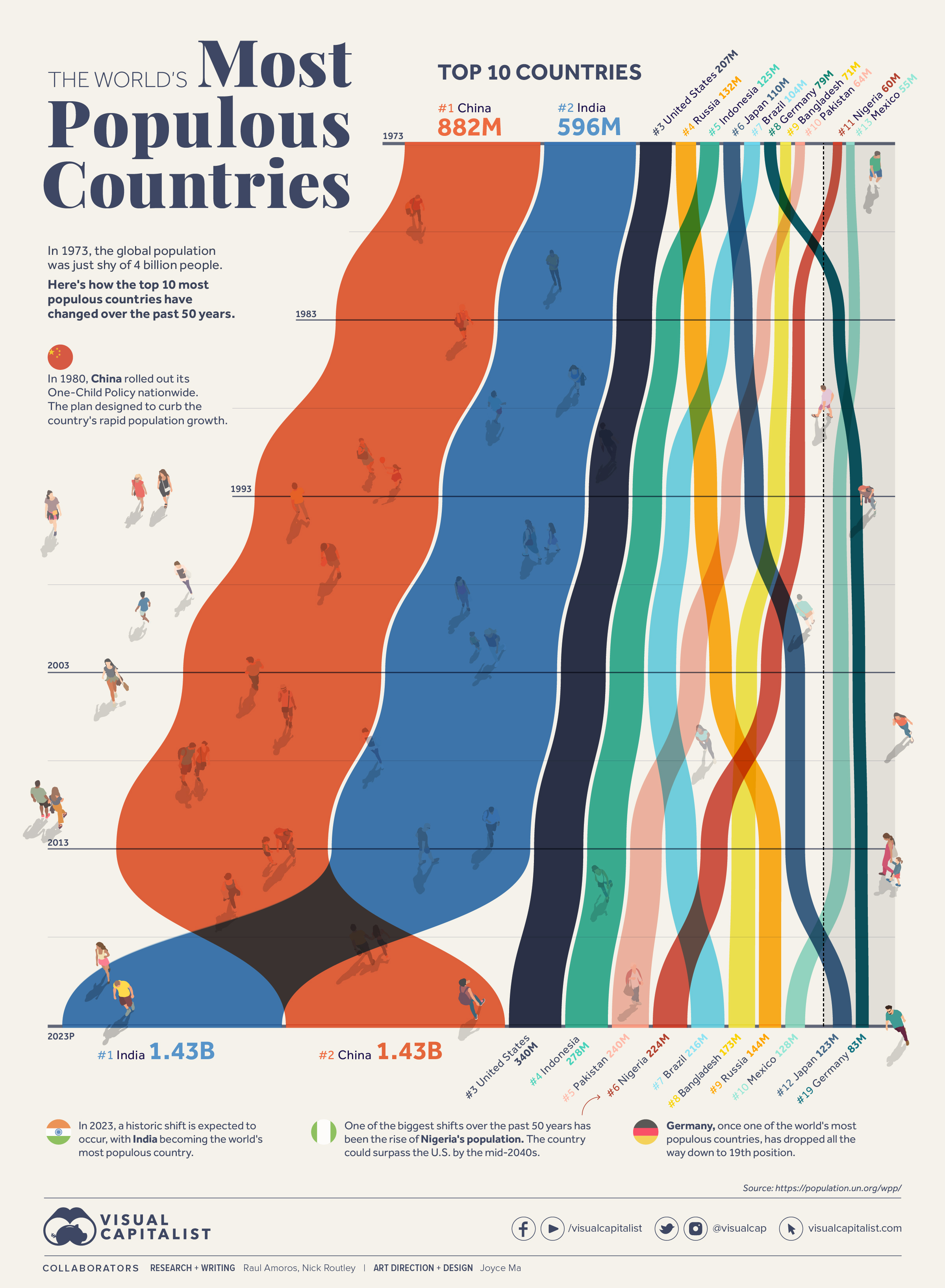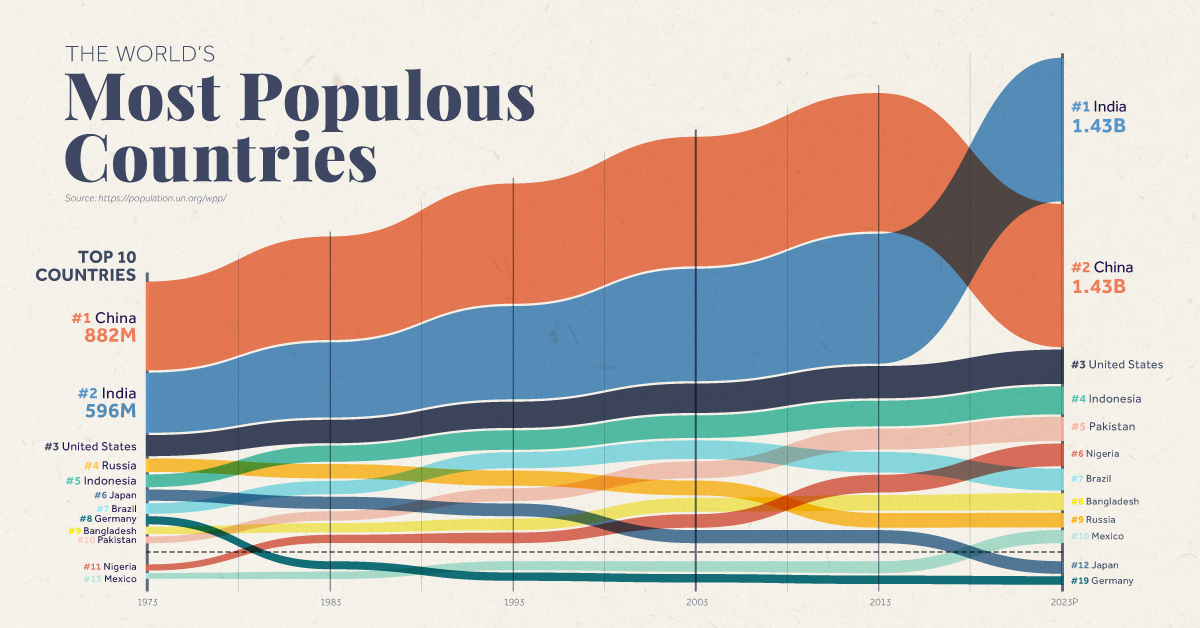Demographics
Charted: The World’s Most Populous Countries (1973–2023)

The World’s Most Populous Countries (1973–2023)
Humankind is now double the size it was in 1973.
Of course, that growth has been far from uniform, and the ranking of the world’s most populous countries continues to evolve.
Using the latest data available from the United Nations, we’ve looked at which countries have the largest share of the planet’s eight billion people.
The Top 10 Most Populous Countries
Here are the countries shown above, including how much they’ve grown over the past 50 years:
| Country | Population (1973) | Population (2023) | Change (1973–2023) |
|---|---|---|---|
| 🇨🇳 China | 881,652,084 | 1,425,671,353 | 544,019,269 |
| 🇮🇳 India | 596,107,487 | 1,428,627,666 | 832,520,179 |
| 🇺🇸 United States | 207,314,772 | 339,996,567 | 132,681,795 |
| 🇷🇺 Russia | 132,191,636 | 144,444,360 | 12,252,724 |
| 🇮🇩 Indonesia | 124,709,060 | 277,534,118 | 152,825,058 |
| 🇯🇵 Japan | 109,679,473 | 123,294,516 | 13,615,043 |
| 🇧🇷 Brazil | 103,666,906 | 216,422,450 | 112,755,544 |
| 🇩🇪 Germany | 78,667,473 | 83,294,634 | 4,627,161 |
| 🇧🇩 Bangladesh | 71,144,816 | 172,954,325 | 101,809,509 |
| 🇵🇰 Pakistan | 64,285,630 | 240,485,666 | 176,200,036 |
| 🇳🇬 Nigeria | 59,605,450 | 223,804,636 | 164,199,186 |
| 🇲🇽 Mexico | 55,228,202 | 128,455,563 | 73,227,361 |
The numbers above highlight the extreme variance in growth for these world’s most populous countries. While Germany has grown by just 6% over the past 50 years, Pakistan and Nigeria have nearly quadrupled their populations.
Half a century ago, there were only six countries with populations of over 100 million. Today, there are 15 countries past that mark, with Vietnam positioned to hit that milestone next.
The Top 20 Most Populous Countries
Things get even more interesting when we examine the top 20 most populous countries over the same time period.
| Country | Population (1973) | Rank (1973) | Population (2023) | Rank (2023) |
|---|---|---|---|---|
| 🇨🇳 China | 881,652,084 | 1 | 1,425,671,353 | 2 |
| 🇮🇳 India | 596,107,487 | 2 | 1,428,627,666 | 1 |
| 🇺🇸 United States | 207,314,772 | 3 | 339,996,567 | 3 |
| 🇷🇺Russia | 132,191,636 | 4 | 144,444,360 | 9 |
| 🇮🇩 Indonesia | 124,709,060 | 5 | 277,534,118 | 4 |
| 🇯🇵 Japan | 109,679,473 | 6 | 123,294,516 | 12 |
| 🇧🇷 Brazil | 103,666,906 | 7 | 216,422,450 | 7 |
| 🇩🇪 Germany | 78,667,473 | 8 | 83,294,634 | 19 |
| 🇧🇩 Bangladesh | 71,144,816 | 9 | 172,954,325 | 8 |
| 🇵🇰 Pakistan | 64,285,630 | 10 | 240,485,666 | 5 |
| 🇳🇬 Nigeria | 59,605,450 | 11 | 223,804,636 | 6 |
| 🇬🇧 United Kingdom | 56,166,630 | 12 | 67,736,798 | 21 |
| 🇲🇽 Mexico | 55,228,202 | 13 | 128,455,563 | 10 |
| 🇮🇹 Italy | 54,379,587 | 14 | 58,870,763 | 25 |
| 🇫🇷 France | 51,814,077 | 15 | 64,756,586 | 23 |
| 🇺🇦 Ukraine | 48,301,548 | 16 | 36,744,635 | 41 |
| 🇻🇳 Vietnam | 44,891,286 | 17 | 98,858,947 | 16 |
| 🇵🇭 Philippines | 40,406,232 | 18 | 117,337,366 | 13 |
| 🇹🇭 Thailand | 38,873,065 | 19 | 71,801,281 | 20 |
| 🇹🇷 Turkey | 38,028,236 | 20 | 85,816,192 | 18 |
| 🇪🇬 Egypt | 37,120,778 | 21 | 112,716,599 | 14 |
| 🇮🇷 Iran | 30,981,903 | 25 | 89,172,768 | 17 |
| 🇪🇹 Ethiopia | 30,694,321 | 26 | 126,527,064 | 11 |
| 🇨🇩 DRC | 21,853,908 | 32 | 102,262,812 | 15 |
Looking back 50 years ago, Nigeria was the lone African nation in the top 20. Today, it is joined by Ethiopia, Egypt, and the Democratic Republic of the Congo – all of which have experienced staggering population growth.
African nations are expected to lead population growth over the next few decades. By 2100, one quarter of the world’s people are expected to be African.
Europe is the flip side of this equation. Back in 1973, there were six European countries in this top list. Today, only Russia and Germany remain, with the latter country soon to fall out of the top 20 ranking.
Ukraine, which was shrinking, is expected to fall to at least 41st place due to the turmoil surrounding the Russian invasion of the country. Since the invasion began in February 2022, nearly 14 million border crossings have been recorded from Ukraine to other countries.
How Big Will Populations Get?
Once India becomes the world’s largest country, it will likely remain so for many decades in the future, peaking in the 2060s (unless there are substantial changes in projected growth rates). India’s peak population will stand at around 1.7 billion people.
The world’s population is expected to peak later, around the 2080s. Humanity’s peak population is expected to be about 10.5 billion.
Demographics
The Countries That Have Become Sadder Since 2010
Tracking Gallup survey data for more than a decade reveals some countries are witnessing big happiness declines, reflecting their shifting socio-economic conditions.

The Countries That Have Become Sadder Since 2010
This was originally posted on our Voronoi app. Download the app for free on iOS or Android and discover incredible data-driven charts from a variety of trusted sources.
Can happiness be quantified?
Some approaches that try to answer this question make a distinction between two differing components of happiness: a daily experience part, and a more general life evaluation (which includes how people think about their life as a whole).
The World Happiness Report—first launched in 2012—has been making a serious go at quantifying happiness, by examining Gallup poll data that asks respondents in nearly every country to evaluate their life on a 0–10 scale. From this they extrapolate a single “happiness score” out of 10 to compare how happy (or unhappy) countries are.
More than a decade later, the 2024 World Happiness Report continues the mission. Its latest findings also include how some countries have become sadder in the intervening years.
Which Countries Have Become Unhappier Since 2010?
Afghanistan is the unhappiest country in the world right now, and is also 60% unhappier than over a decade ago, indicating how much life has worsened since 2010.
In 2021, the Taliban officially returned to power in Afghanistan, after nearly two decades of American occupation in the country. The Islamic fundamentalist group has made life harder, especially for women, who are restricted from pursuing higher education, travel, and work.
On a broader scale, the Afghan economy has suffered post-Taliban takeover, with various consequent effects: mass unemployment, a drop in income, malnutrition, and a crumbling healthcare system.
| Rank | Country | Happiness Score Loss (2010–24) | 2024 Happiness Score (out of 10) |
|---|---|---|---|
| 1 | 🇦🇫 Afghanistan | -2.6 | 1.7 |
| 2 | 🇱🇧 Lebanon | -2.3 | 2.7 |
| 3 | 🇯🇴 Jordan | -1.5 | 4.2 |
| 4 | 🇻🇪 Venezuela | -1.3 | 5.6 |
| 5 | 🇲🇼 Malawi | -1.2 | 3.4 |
| 6 | 🇿🇲 Zambia | -1.2 | 3.5 |
| 7 | 🇧🇼 Botswana | -1.2 | 3.4 |
| 8 | 🇾🇪 Yemen | -1.0 | 3.6 |
| 9 | 🇪🇬 Egypt | -1.0 | 4.0 |
| 10 | 🇮🇳 India | -0.9 | 4.1 |
| 11 | 🇧🇩 Bangladesh | -0.9 | 3.9 |
| 12 | 🇨🇩 DRC | -0.7 | 3.3 |
| 13 | 🇹🇳 Tunisia | -0.7 | 4.4 |
| 14 | 🇨🇦 Canada | -0.6 | 6.9 |
| 15 | 🇺🇸 U.S. | -0.6 | 6.7 |
| 16 | 🇨🇴 Colombia | -0.5 | 5.7 |
| 17 | 🇵🇦 Panama | -0.5 | 6.4 |
| 18 | 🇵🇰 Pakistan | -0.5 | 4.7 |
| 19 | 🇿🇼 Zimbabwe | -0.5 | 3.3 |
| 20 | 🇮🇪 Ireland | -0.5 | 6.8 |
| N/A | 🌍 World | +0.1 | 5.5 |
Nine countries in total saw their happiness score drop by a full point or more, on the 0–10 scale.
Noticeably, many of them have seen years of social and economic upheaval. Lebanon, for example, has been grappling with decades of corruption, and a severe liquidity crisis since 2019 that has resulted in a banking system collapse, sending poverty levels skyrocketing.
In Jordan, unprecedented population growth—from refugees leaving Iraq and Syria—has aggravated unemployment rates. A somewhat abrupt change in the line of succession has also raised concerns about political stability in the country.
-

 Mining1 week ago
Mining1 week agoGold vs. S&P 500: Which Has Grown More Over Five Years?
-

 Markets2 weeks ago
Markets2 weeks agoRanked: The Most Valuable Housing Markets in America
-

 Money2 weeks ago
Money2 weeks agoWhich States Have the Highest Minimum Wage in America?
-

 AI2 weeks ago
AI2 weeks agoRanked: Semiconductor Companies by Industry Revenue Share
-

 Markets2 weeks ago
Markets2 weeks agoRanked: The World’s Top Flight Routes, by Revenue
-

 Countries2 weeks ago
Countries2 weeks agoPopulation Projections: The World’s 6 Largest Countries in 2075
-

 Markets2 weeks ago
Markets2 weeks agoThe Top 10 States by Real GDP Growth in 2023
-

 Demographics2 weeks ago
Demographics2 weeks agoThe Smallest Gender Wage Gaps in OECD Countries

















